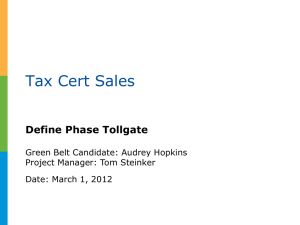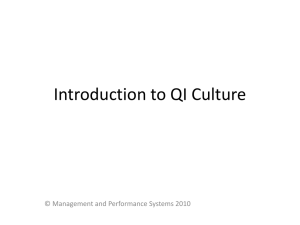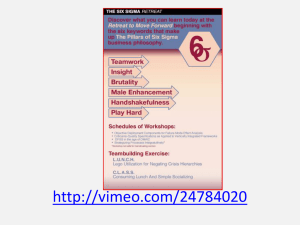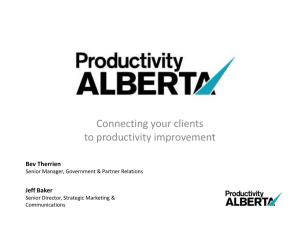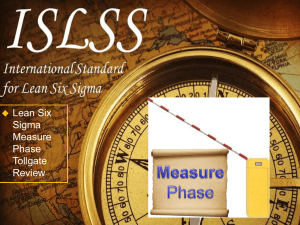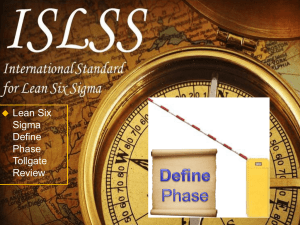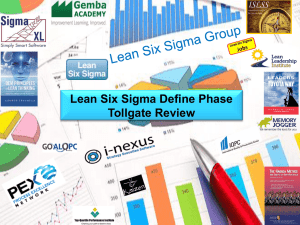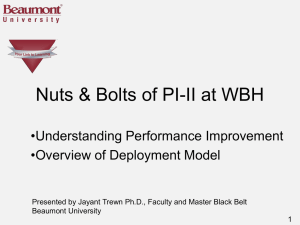DMAIC Process Templates (ppt format)
advertisement
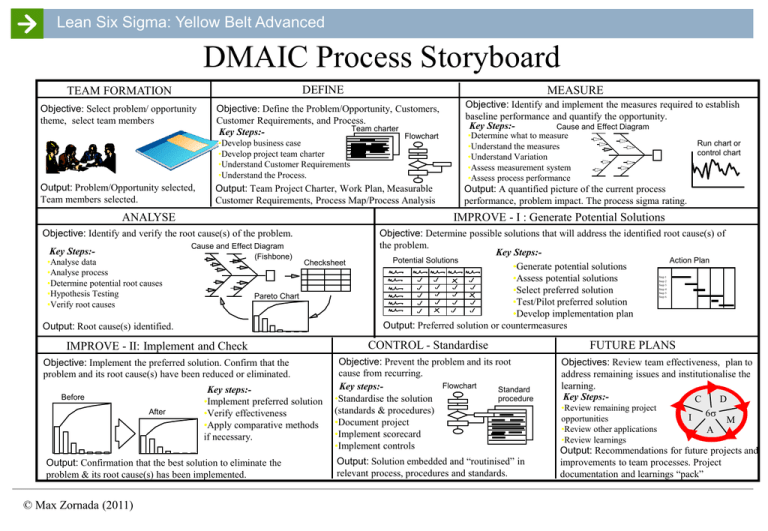
Lean Six Sigma: Yellow Belt Advanced DMAIC Process Storyboard DEFINE TEAM FORMATION Objective: Select problem/ opportunity theme, select team members MEASURE Objective: Define the Problem/Opportunity, Customers, Customer Requirements, and Process. Team charter Key Steps:Flowchart Objective: Identify and implement the measures required to establish baseline performance and quantify the opportunity. Key Steps:Cause and Effect Diagram Output: Team Project Charter, Work Plan, Measurable Customer Requirements, Process Map/Process Analysis Output: A quantified picture of the current process performance, problem impact. The process sigma rating. •Develop business case •Develop project team charter •Understand Customer Requirements •Understand the Process. Output: Problem/Opportunity selected, Team members selected. ANALYSE Key Steps:- Cause and Effect Diagram (Fishbone) Checksheet Pareto Chart Output: Root cause(s) identified. IMPROVE - II: Implement and Check Objective: Implement the preferred solution. Confirm that the problem and its root cause(s) have been reduced or eliminated. Before After Key steps:•Implement preferred solution •Verify effectiveness •Apply comparative methods if necessary. Output: Confirmation that the best solution to eliminate the problem & its root cause(s) has been implemented. © Max Zornada (2011) Run chart or control chart IMPROVE - I : Generate Potential Solutions Objective: Identify and verify the root cause(s) of the problem. •Analyse data •Analyse process •Determine potential root causes •Hypothesis Testing •Verify root causes •Determine what to measure •Understand the measures •Understand Variation •Assess measurement system •Assess process performance Objective: Determine possible solutions that will address the identified root cause(s) of the problem. Key Steps:Potential Solutions Action Plan •Generate potential solutions •Assess potential solutions •Select preferred solution •Test/Pilot preferred solution •Develop implementation plan Output: Preferred solution or countermeasures Step 1 Step 2 Step 3 Step 4 Step 5 Step 6 CONTROL - Standardise Objective: Prevent the problem and its root cause from recurring. Flowchart Key steps:Standard procedure •Standardise the solution (standards & procedures) •Document project •Implement scorecard •Implement controls Output: Solution embedded and “routinised” in relevant process, procedures and standards. FUTURE PLANS Objectives: Review team effectiveness, plan to address remaining issues and institutionalise the learning. Key Steps:D C •Review remaining project 6 I opportunities M •Review other applications A •Review learnings Output: Recommendations for future projects and improvements to team processes. Project documentation and learnings “pack” Lean Six Sigma: Yellow Belt Advanced © Max Zornada (2011) Lean Six Sigma: Yellow Belt Advanced DMAIC Process Storyboard TEAM FORMATION ANALYSE IMPROVE - II: Implement and Check © Max Zornada (2011) DEFINE MEASURE IMPROVE - I : Generate Potential Solutions CONTROL - Standardise FUTURE PLANS Lean Six Sigma: Yellow Belt Advanced © Max Zornada (2011) Lean Six Sigma: Yellow Belt Advanced Lean Six Sigma Project Charter Project Title Expected Financial Impact Process Green Belt Champion Telephone Number Organization/Function Start Date Target Completion Date Problem/Opportunity Definition What is the Problem to be solved or the opportunity this project will exploit. Objective Improvement target, impact on Sigma, COQ/COPQ and Customer Satisfaction Business Case What improvement in business performance is expected. $ impact and by when. Who are the team members and key experts to be consulted. Team Members Customer Benefit Which part of the process will be investigated Who are the final customers. What benefits will they see and what are their most critical requirements. Schedule What are key milestone dates for completion of each stage. Project Scope © Max Zornada (2011) Define completion Measure completion Analyse completion Improve completion Control completion Project Completion Lean Six Sigma: Yellow Belt Advanced © Max Zornada (2011) Lean Six Sigma: Yellow Belt Advanced Example: SEFP’s Customer Requirements Statement Outputs: Customer: Customer Requirements Measure Target Importance to Customer Customer Satisfaction Priority Rating (Importance x Satisfaction) What is this customer’s major complaint? What issue would they want us to work on? Ranking Scheme Importance to customer: Customer Satisfaction: © Max Zornada (2011) 1 = Nice to Have, 1 = Very Satisfied, 2 = Important, 2 = OK. Could be better, 3 = Critical, Must Have 3 = Unhappy, Must be improved Lean Six Sigma: Yellow Belt Advanced © Max Zornada (2011) Lean Six Sigma: Yellow Belt Advanced Pareto Analysis © Max Zornada (2011) Lean Six Sigma: Yellow Belt Advanced © Max Zornada (2011) Lean Six Sigma: Yellow Belt Advanced Fishbone Diagram People Equipment/Systems © Max Zornada (2011) Procedures Materials/Environment Lean Six Sigma: Yellow Belt Advanced © Max Zornada (2011) Lean Six Sigma: Yellow Belt Advanced Potential Solutions Matrix Potential Solutions Cost Ranking Ease of Implementation Scale: 0 = None, 1 = Low, 3 = Moderate, 9 = Strong © Max Zornada (2011) % of problem it fixes Overall Ranking Lean Six Sigma: Yellow Belt Advanced © Max Zornada (2011)

